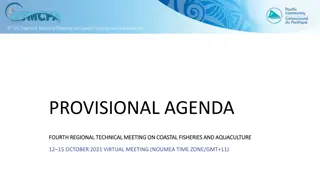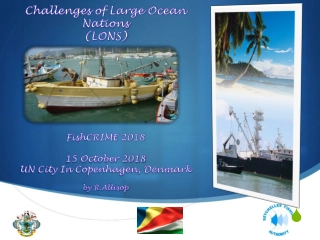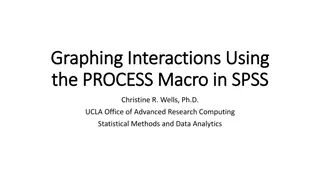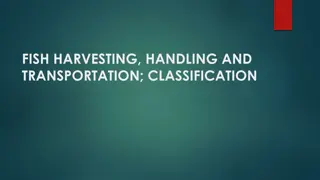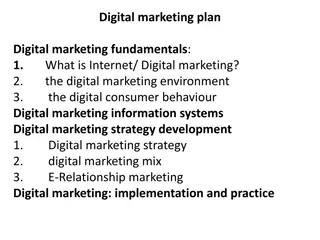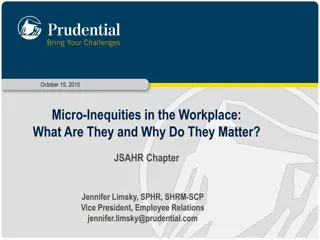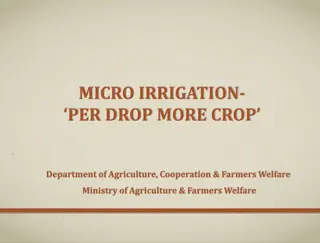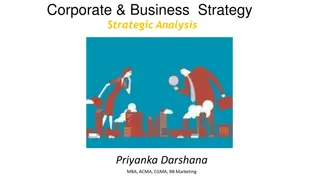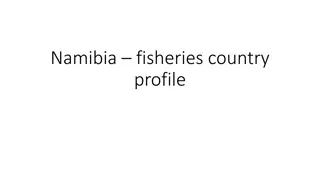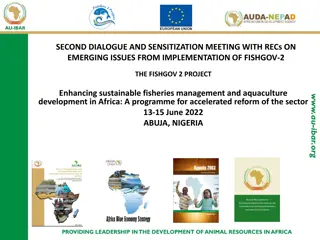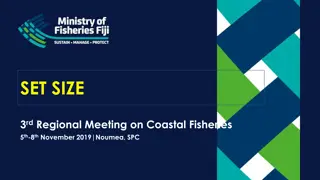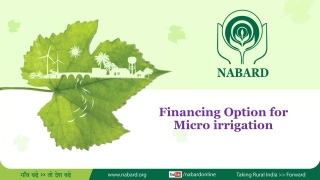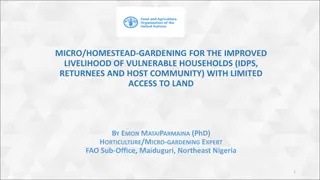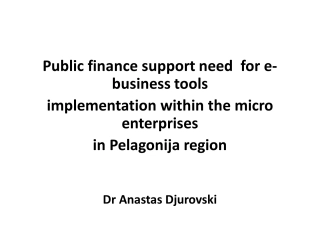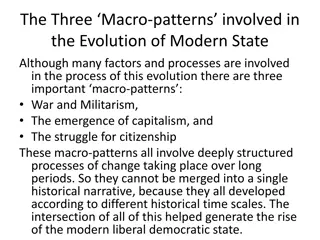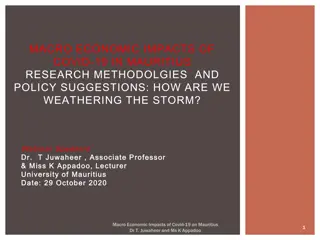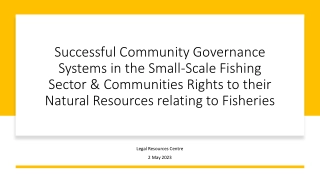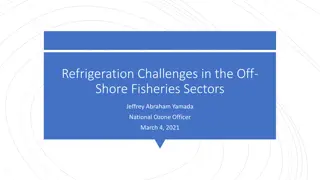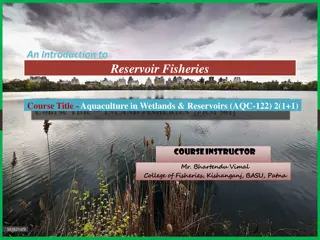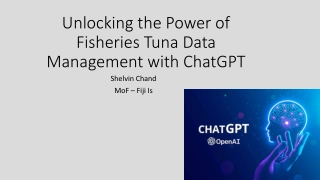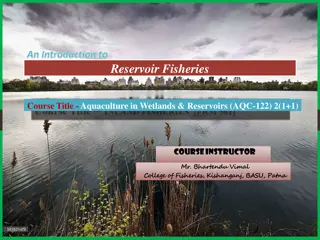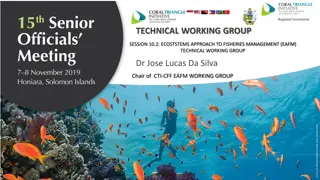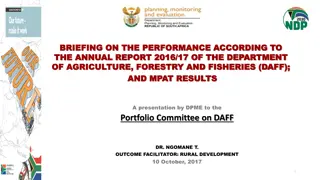Understanding Fisheries Finance: Macro vs. Micro Level Perspectives
Fisheries finance involves studying the financial aspects of the fishing and aquaculture business. It can be approached at both macro and micro levels, focusing on raising funds, lending procedures, and individual enterprise financial management. Macro-finance deals with the aggregate financial needs of the fisheries sector, while micro-finance focuses on individual fishery enterprises. Credit plays a vital role in fisheries development, with the need for accessible and affordable credit sources being crucial for the growth of the sector.
Download Presentation

Please find below an Image/Link to download the presentation.
The content on the website is provided AS IS for your information and personal use only. It may not be sold, licensed, or shared on other websites without obtaining consent from the author. Download presentation by click this link. If you encounter any issues during the download, it is possible that the publisher has removed the file from their server.
E N D
Presentation Transcript
Fisheries Finance
Meaning Fisheries finance generally means studying, examining and analysing aspects pertaining to fishing/ aquaculture business, which is the core sector of India. The financial aspects matters relating to production of fish and fishery products and their disposal. the financial include money
Nature and Scope: Fisheries finance can be dealt at both micro level and macro level. Macrofinance deals with different sources of raising funds for fisheries as a whole in the economy. It is also concerned with the lending procedure, monitoring and controlling agricultural credit institutions. Hence macro- finance is related to financing of fisheries at aggregate level. rules, regulations, of different
Micro-finance refers to financial management of the individual fishery enterprises units. And it is concerned with the study as to how the individual fishers/ aqua various sources of credit, quantum of credit to be borrowed from each source and how he allocates the same among the alternative uses with in the farm. It is also concerned with the future use of funds. farmer considers
Therefore, macro-finance deals with the aspects relating to total credit needs of the fisheries sector, the terms and conditions under which the credit is available and the method of use of total credit for the development of fisheries, while micro-finance refers management of individual fisheries enterprise. to the financial
Credit The word credit comes from the Latin word Credo which means I believe . Hence credit is based up on belief, confidence, trust and faith. Credit is other wise called as loan. Definition: Credit / loan is certain amount of money provided for certain conditions with some interest, which can be repaid sooner (or) later. According to Professor Galbraith credit is the temporary transfer of asset from one who has to other who has not certain purpose on
Credit needs in Fisheries: Fisheries credit is one of the most crucial inputs in all fisheries programmes. For a long time, the major source of fisheries moneylenders. But this source of credit was inadequate, highly exploitative. To curtail this, a multi-agency approach consisting of cooperatives, banks ands regional rural banks credit has been adopted to provide cheaper, timely and adequate credit to fishers/ farmers. development credit was private expensive and commercial
The financial requirements of the Indian fishers/ farmers are for 1. Buying fisheries inputs like crafts, gears, implements, seeds, fertilizers, crop protection pro-biotics, feed etc. 2. Supporting their families in those years when the landings/ crops have not been good. 3. Buying additional improvements on the existing boats /land, to clear old debt and purchase costly machinery. 4. Increasing the fishing efficiency as against limiting resources i.e. hiring of skilled labour and machinery. crafts/land, to make
Credit is broadly classified based on various criteria: 1. Based on time: This classification is based on the repayment period of the loan. It is sub-divided in to 3 types Short term loans: These loans are to be repaid within a period of 6 to 18 months. All aquaculture loans are said to be short term loans, but the length of the repayment period varies according to the duration of crop. The aqua-farmers require this type of credit to meet the expenses operations on the farm like sowing, feed application, crop protection measures(probiotics), payment of wages to casual labourers etc. The borrower is supposed to repay the loan from the sale proceeds of the crops raised. of the ongoing culture
Medium term loans: Here the repayment period varies from 18 months to 5 years. These loans are required by the aqua-farmers for bringing about some improvements on his farm by way of purchasing electric motors, etc. The relatively longer period of repayment of these loans is due to their partially-liquidating nature. implements,
Long term loans: These loans fall due for repayment over a long time ranging from 5 years to more than 20 years or even more. These loans together with medium terms loans are called investment loans or term loans. These loans are meant improvements like levelling and reclamation of land, construction of farm buildings, purchase of tractors, raising of plantations ,etc. Since these activities require large capital, a longer period is required to repay these loans due to their non - liquidating nature for permanent
Based on Purpose: Based on purpose Credit is sub-divided in to 4 types. Production loans: These loans refer to the credit given to the aqua-farmers for crop production and are intended to increase the production of crops. They are also called as seasonal aquaculture/ fisheries operations (SAO) loans or short term loans or crop loans. These loans are repayable with in a period ranging from 6 to 18 months in lumpsum.
Investment purchase of equipment the productivity of which is distributed over more than one year. Loans given for aerators, pumpsets, tube wells, etc. Marketing loans: These loans are meant to help the farmers in overcoming the market the produce in a better way. Regulated markets and commercial banks, based on the warehouse receipt are lending in the form of marketing loans by advancing 75 per cent of the value of the produce. These loans help the farmers to clear off their debts and dispose the produce at remunerative prices). loans: These are loans given for distress sales and to
Consumption loan Consumption loans: Any loan advanced for some purpose other than production is broadly categorized as consumption loan. These unproductive but indirectly assist in more productive use of the crop loans i.e. with out diverting then to other purposes. Consumption loans are not very widely advanced and restricted to the areas which are hit by natural calamities. These loans are extended based on group guarantee basis with a maximum of three members. The loan is to be repaid with in 5 crop seasons or 2.5 years whichever is less. The branch manager is vested with the discretionary power of sanctioning these loans up to Rs. 5000 in each individual case. The rate of interest is around 11 per cent. loans seem to be
4. Based on security: The loan transactions between lender and borrower are governed by confidence and this assumption is confined to private lending to some institutional financial agencies do have their own procedural formalities on credit transactions. Therefore it is essential to classify the loans under this category into two secured and unsecured loans. Secured loans: Loans advanced against some security by the borrower are termed as secured loans. Various forms of securities are offered in obtaining the loans and they are of following types extent, but the sub-categories viz.,
I. Personal security: Under this, borrower himself stands as the guarantor. Loan is advanced on the aqua-farmer s promissory note. Third party guarantee may or may not be insisted upon (i.e. based on the understanding lender and the borrower) II. Collateral Security: pledged to secure properties of the individuals like LIC bonds, fixed deposit bonds, warehouse receipts, machinery, livestock etc, are offered as security. between the Here loan. the property The movable is a
III. Chattel loans: Here credit is obtained from pawn-brokers by pledging movable properties such as jewellery, utensils made of various metals, etc. IV. Mortgage: As against to collateral security, immovable properties are presented for security purpose For example, land, farm buildings, etc. The person who is creating the charge of mortgage is called mortgagor (borrower) and the person in whose favour it is created is known as the mortgagee (banker). Mortgages are of two types
a) Simple mortgage: When the mortgaged property is ancestrally inherited property of borrower then simple mortgage holds good. Here, the farmer borrower has to register his property in the name of the banking institution as a security for the loan he obtains. The registration charges are to be borne by the borrower. b) Equitable mortgage: When the mortgaged property is self-acquired borrower, then equitable applicable. In this no required, because the ownership rights are clearly specified in the title deeds in the name of farmer-borrower. property mortgage such registration of the is is
V. Hypothecated loans: Borrower has ownership right on his movable and the banker has legal right to take a possession of property to sale on default (or) a right to sue the owner to bring the property to sale and for realization of the amount due. The person who creates hypothecation is called (borrower) and the person in whose favor it is created is known as hypothecate (bank) and the property, which hypothecated property. the as charge hypothecator of is denoted as
This happens in the case of tractor loans, machinery loans etc. Under such loans the borrower will not have any right to sell the equipment until the loan is cleared off. The borrower is allowed to use the purchased machinery or equipment so as to enable him pay the loan installment regularly. Hypothecated loans again are of two types viz., key loans and open loans.
a) Key loans : The agricultural produce of the farmer - borrower will be kept under the control of lending institutions and the loan is advanced to the farmer . This helps the farmer from not resorting to distress sales. b) Open loans: Here possession of the purchased machinery rests with the borrower, but the legal ownership remains with the lending institution till the loan is repaid. Unsecured loans: Just based on the confidence between the borrower and lender, the loan transactions take place. No security is kept against the loan amount only the physical
Lenders classification: Institutional advanced by the institutional agencies like co- operatives, commercial operative loans and commercial bank loans. Non-institutional credit : Here the individual persons will lend the loans Ex: Loans given by professional and fisheries traders, commission agents, relatives, friends, etc. credit: Here are loans are banks. Ex: Co- money lenders,
Borrowers classification: The credit is also classified on the basis of type of borrower. This classification considerations. Based on the business activity like farmers, dairy farmers, poultry farmers, fish farmers, rural artisans etc. Based on size of the farm: fish culture labourers, marginal farmers, small farmers , medium farmers , large farmers , Based on location hill farmers (or) tribal farmers. has equity
Based on liquidity Self-liquidating loans: They generate income immediately and are to be paid with in one year or after the completion of one crop season. Ex: crop loans. Partially -liquidating: They will take some time to generate income and can be repaid in 2-5 years or more, based on the economic activity for which the loan was taken. Ex: tractor loans, plantation loans etc.,
Based on approach: Individual approach: Loans advanced to individuals for different purposes will fall under this category Area based approach: Loans given to the persons falling under given area for specific purpose will be categorized under this. Ex: Drought Prone Area Programme (DPAP) loans, etc Differential Interest Rate (DIR) approach: Under this approach loans will be given to the weaker sections @ 4 per cent per annum.
Based on contact Direct Loans: Loans extended to the farmers directly are called direct loans. Ex: Crop loans. Indirect loans: Loans given to the processing based companies/ firms which are indirectly beneficial to the farmers are called indirect loans.


